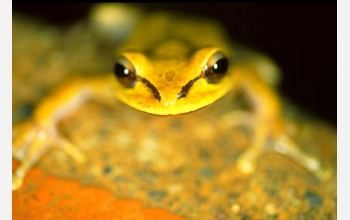Multimedia Gallery
A Hylid Frog From Costa Rica
A Hylid frog (commonly called a tree frog) from Costa Rica. [Image 2 of 2 related images. See Image 1.]
More about this Image
In the 1980s, reports began to accumulate about the decline of frogs and toads in pristine environments such as nature reserves and parks. This greatly concerned ecologists who look at amphibians as an indicator species, a warning of environmental stress. The metamorphic life cycle of amphibians--often egg to tadpole (or other water-living larva) to land-based adult--relies upon both aquatic and terrestrial habitats. Therefore, because they lack such exterior protection as scales, feathers and hair, they are very sensitive to changes that may occur in their external environment.
Biologist Joseph Kiesecker has been studying the population decline of various species of amphibians for years. One of his studies focused on the outbreak of disease in amphibians in the Cascade Mountains of Oregon. He found that although the Cascades frog, western toad and Pacific tree frog could lay their eggs in one pond next to each other, the Cascades frog and western toad populations were declining while the Pacific tree frog remained stable.
In a laboratory study, Kiesecker took embryos of all three species and put them in enclosures where some were exposed to ultraviolet radiation and others were not. Of the exposed embryos, only the Pacific tree frog was resistant to disease. The ultraviolet light had stressed the embryos of the other species and damaged their DNA, making them more susceptible to infection. The Pacific tree frog had a better DNA-repair mechanism, giving it the ability to repair the damage. Based on this study, Kiesecker believes that exposure to ultraviolet radiation may be responsible for some of the mortality patterns in amphibians.
Another study of Kiesecker's focused on the gross deformities that began to appear in amphibians across the United States since the late 1980s. Frogs, toads and other amphibians have been found with missing or extra legs and legs protruding from their backs and heads. Kiesecker found that as trees are cut down, more light reaches ponds. This leads to an increase in algae growth that in turn supports a larger snail population. The snails harbor one stage in the life cycle of the trematode, a parasitic flatworm. The snails release a free-swimming trematode larva that burrow into amphibian embryos and form cysts that cause further damage. In the presence of even slight quantities of pesticides (equal to allowable amounts under EPA drinking water standards), the embryo's immune system is suppressed. The cyst disturbs developing limb buds, resulting in deformed limbs and ultimately death. Kiesecker's studies concluded that the cause is a combination of exposure to agricultural chemicals and infection.
No single explanation explains amphibian decline, but Kiesecker feels it is a combination of contaminants and ultraviolet radiation acting in concert, causing environmental stress. The National Science Foundation (NSF) supports studies like Kiesecker's, seeking answers to these and other environmental mystery that cause the decline and loss of species on Earth. This particular research project was supported by a grant from the National Institutes of Health and by the NSF Panel on the Ecology of Infectious Disease, as well as a grant from the NSF Ecological and Evolutionary Physiology Panel. (Year of image: 2000)
Credit: Joseph Kiesecker, Pennsylvania State University
Images and other media in the National Science Foundation Multimedia Gallery are available for use in print and electronic material by NSF employees, members of the media, university staff, teachers and the general public. All media in the gallery are intended for personal, educational and nonprofit/non-commercial use only.
Images credited to the National Science Foundation, a federal agency, are in the public domain. The images were created by employees of the United States Government as part of their official duties or prepared by contractors as "works for hire" for NSF. You may freely use NSF-credited images and, at your discretion, credit NSF with a "Courtesy: National Science Foundation" notation.
Additional information about general usage can be found in Conditions.
Also Available:
Download the high-resolution JPG version of the image. (873 KB)
Use your mouse to right-click (Mac users may need to Ctrl-click) the link above and choose the option that will save the file or target to your computer.

